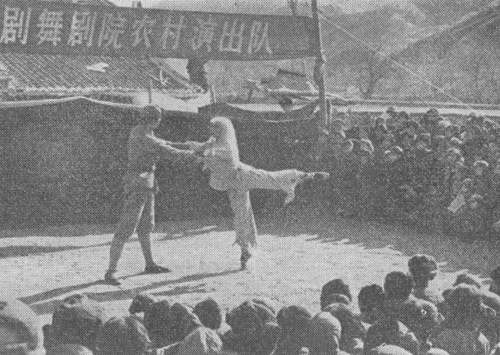|
 |
|
A troupe of the Central Opera and Dance Drama Theatre presenting the ballet The White-Haired Girl in a village north of the Great Wall, by the Kuanting Reservoir |
The present mass flow of artists to the villages follows the fine tradition created by the cultural troupes of the people's army during the revolutionary civil wars and the war against the Japanese invaders. In the face of great hardships, the travelling propaganda troupes of those days made a big contribution to the struggle by spreading the revolutionary message and heartening the people's fighters.
It was as early as in 1942 that Chairman Mao laid it down as a policy that revolutionary artists and writers should serve and integrate themselves with the workers, peasants and people's fighters who form the overwhelming majority of the Chinese people. Therefore following this policy and tradition, from the very early days of liberation, the various art troupes of the urban areas made it a regular practice to take their performances out on tour to other cities, the smaller towns, factories, and army units. But the present movement in scale and content is a new development of that policy and tradition under new conditions. It is a manifestation of the deepening socialist revolution on the cultural front.
The great historical advance of the Chinese socialist revolution has placed new demands on the arts and artists. In the factories, farms and army units, the masses are fighting in the front lines of the socialist revolution and construction. There they want and need a socialist culture that stimulates their enthusiasm in revolution and production, that is closely integrated with their life, their urgent problems and desires. They demand a socialist art placed wholly at the disposal of the working people. This means that if our artists are to meet these needs they must create art with a new contemporary socialist content and find new forms designed to make maximum use of our cultural forces.
To produce that art based on close knowledge of the life of the people in various spheres of activity, our artists must closely identify themselves with the people and remould their outlook and ideology in tune with the people. They have had considerable success in this. They are now staging plays and operas on modern revolutionary themes; they portray the new heroes of the working people in socialist revolution and construction; they combat the hostile influences of feudalism and capitalism in the ideological field. By routing out-of-date ideas and ways of doing things they help to clear the ground for the growth of new socialist thinking.
But that is still not enough. Their art must not only come from the heart of the life of the people; it must be brought to the doorsteps of the people where it can engender living force to propel society forward. Our artists are duty bound to answer these historic, revolutionary demands. Thus, under the impact of socialist construction and the socialist cultural revolution comes this mounting upsurge in the movement to bring socialist art to the factories, army units and villages, even the most remote. | 